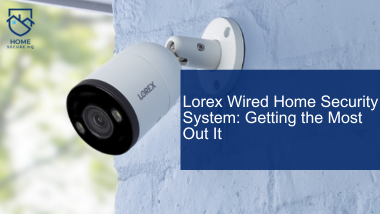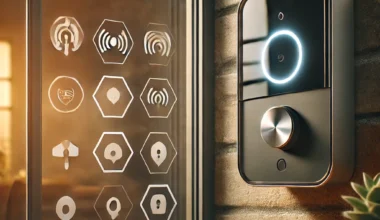Have you ever asked yourself if your home security devices are truly protecting every area or if there are blind spots that an intruder could use?

For parents keeping children safe or homeowners looking for peace of mind, placement is just as important as the device itself.
Many people invest in security gadgets, but without the best beam detector placement, those tools cannot work as effectively as they should.
This guide will show you the smartest places to install beam detectors indoors and outdoors so you can cover every corner of your home without making things complicated.
Whether you’re a parent, traveler, renter, or simply someone who values safety, you’ll find easy, practical tips to get the most from your security system.
Why Beam Detector Placement Matters

Coverage vs. Blind Spots
When it comes to home security, placement is everything. Even the best security device loses its power if it’s not installed in the right location.
The best beam detector placement gives your home full coverage, leaving no corner exposed. Poorly placed detectors create gaps or blind spots that intruders can easily use to enter.Think of it this way: securing only your front door while leaving your backyard unprotected is like leaving an open invitation.
Parents may believe their children are safe, but a blind spot near a back window or side entrance could go unnoticed.
For renters and travelers, this mistake is even riskier, because you may think your setup is solid when in reality, you’re only half protected.
Proper coverage means checking all entry and exit points front and back doors, garage access, basement windows, and outdoor paths. When each of these areas is covered, beam detectors work as intended: creating an invisible shield around your home.
Deterrence Factor
Another key reason to focus on the best beam detector placement is deterrence. A detector placed in the right spot doesn’t just catch intruders, it warns them away before they even try.
Criminals often target homes with weak spots, but when they see visible security features guarding entrances and walkways, they are far more likely to move on.
Placing detectors near doors, windows, and driveways sends a clear signal: this home is protected.
For families, that means peace of mind knowing kids can play safely. For renters or frequent travelers, it’s a reassurance that your property looks secure even when you’re away.
Correct placement turns beam detectors into both a shield and a warning sign, maximizing security while making your home a less attractive target.
Best Indoor Placement for Beam Detectors

Entry Points Inside the Home
The first places to consider when planning the best beam detector placement are your entry points. These include the doors and windows intruders are most likely to target.
If these spots are left unprotected, your home will always have weak links no matter how many other detectors you install.
Here are the most important areas to cover:
- Front door: The most common entry point for both family members and intruders.
- Back door: Often overlooked but a favorite target for burglars.
- Garage door: Especially if it connects directly to the house.
- Ground-floor windows: Easy access points that need strong protection.
- Patio or sliding doors: Large and often hidden, making them vulnerable to forced entry.
Placing detectors at these spots creates a security barrier that alerts you right away if someone tries to enter.
For parents, this adds safety by monitoring who comes and goes. For renters and travelers, it brings peace of mind knowing the weakest points of the home are protected with even a simple setup.
Hallways and Staircases
Another effective place for indoor beam detectors is in hallways and staircases. These areas are natural choke points, meaning anyone moving from one room to another must pass through them.
With the right placement, one detector can cover multiple rooms at once, giving you wide protection with fewer devices.
For example, a detector in the main hallway can monitor movement from bedrooms, the living room, and even the kitchen. Staircases are also smart choices because intruders moving between floors can’t avoid them.
By focusing on these high-traffic spots, you maximize indoor coverage without adding unnecessary complexity. This simple approach is a core part of the best beam detector placement, combining both efficiency and effectiveness.
Best Outdoor Placement for Beam Detectors

Driveways and Walkways
One of the smartest ways to use the best beam detector placement is along your driveway and walkways.
These are the first areas anyone must cross to reach your home whether it’s a guest, a delivery person, or a potential intruder.
Installing detectors here gives you an early warning system before someone even reaches your door.
For best results, mount detectors at car height. This way, they can pick up both vehicles and people walking by.
If you live in a busy neighborhood, adjust the sensor range so it only detects movement within your property and not on the street.
Parents find this especially useful for keeping track of kids coming and going, while frequent travelers value the extra layer of protection.
Key driveway and walkway spots include:
- Beginning of the driveway – detects visitors as soon as they arrive.
- Walkways to the front or back door – ensures no one slips by unnoticed.
- Near garages or side entrances – common access points that intruders often target.
Backyard and Side Entrances
Backyards and side entrances are among the most vulnerable areas of a property.
Because they are often hidden from the street, intruders use these spots to approach without being seen.
Including them in your best beam detector placement plan is essential for full coverage.
Strategic backyard and side placements include:
- Garden gates – your first line of defense before anyone enters the yard.
- Fence lines – detects climbing or sneaky attempts to slip through.
- Patio or deck entrances – private spots that burglars often exploit.
- Side or basement doors – commonly forgotten but high-risk entry points.
By securing these hidden zones, you make your property much harder to approach and gain peace of mind knowing that every angle of your home is protected.
Beam Detector Placement Tips for Different Living Situations

For Parents (Safer Homes for Kids)
Parents naturally worry about keeping children safe, especially when kids are playing outdoors or moving around the house.
The best beam detector placement for families is around play areas, backyards, and main entrances.
This ensures that if someone enters the property, parents receive an instant alert.
For example, placing detectors near the backyard gate or garden fence gives peace of mind while kids play outside.
Adding one at the front door or garage helps track when children come and go.
Indoors, positioning detectors in hallways or staircases provide visibility of nighttime movements, offering parents extra reassurance.
This setup not only shields children from outside threats but also creates awareness of everyday activities.
For families, beam detectors work as both a safety shield and a monitoring tool, helping parents feel more in control of their home’s environment.
For Travelers, Renters, and Everyday Consumers
Travelers and renters often face unique security challenges because they need systems that are both effective and easy to set up.
The best beam detector placement here involves options that are non-drill and removable.
For renters, this can include adhesive mounts or free-standing detectors placed at doors, windows, or hallways without causing property damage.
Travelers benefit from portable detectors that are lightweight and easy to move. A small unit can be set near a hotel room door, Airbnb entry, or temporary living space for quick protection.
Everyday consumers who prefer a simple, low-maintenance setup also find this approach useful:
just position detectors at entrances, walkways, and key access points, and you’ll achieve reliable coverage without complexity.
This flexibility shows that beam detectors aren’t limited to homeowners. With the right placement, they adapt to different lifestyles, making security accessible, affordable, and effective for everyone.
Common Mistakes to Avoid When Installing Beam Detectors
Mounting Them Too High or Too Low
A common mistake with the best beam detector placement is installing devices at the wrong height.
If detectors are placed too high, they may miss movement closer to the ground. If they’re too low, pets or even moving objects can trigger false alarms.
The best position is usually chest height, where the sensors can pick up human movement accurately without unnecessary interruptions.
Pointing Them at Sunlight or Reflective Surfaces
Beam detectors depend on light or infrared sensors. When they face strong sunlight, glass doors, or shiny surfaces, the system can get confused.
This often leads to false alerts or weaker performance. To avoid this, angle detectors slightly away from windows, mirrors, or bright reflections.
Doing so ensures reliable detection and keeps your security system working as intended.
Forgetting to Test Range and Angles
Another mistake is skipping the testing phase after installation. Every home layout is different, and obstacles like walls, furniture, or outdoor plants can block signals.
After placing a detector, walk through the space to check coverage. Adjust the angle until the sensor consistently picks up movement.
This step is simple but critical for making the most of the best beam detector placement.
Skipping Regular Cleaning and Maintenance
Beam detectors only work well when sensors are clean and free from obstructions. Dust, dirt, or spider webs can block signals over time.
Unfortunately, many homeowners forget this step. A quick monthly wipe with a soft cloth keeps detectors sharp and prevents false alarms.
Avoiding these common mistakes saves time, reduces frustration, and ensures your detectors provide maximum protection where you need it most.
How to Maximize Security Coverage Without Overcomplicating Things

Combine with Other Security Devices
The best beam detector placement becomes even more effective when paired with other simple security tools.
On their own, detectors add strong protection, but combining them with motion lights, cameras, and alarms creates a complete system.
For example, when a detector senses movement in the driveway, a motion light can switch on to scare off an intruder while a camera records what’s happening.
This layered approach is beginner-friendly and doesn’t require professional installation.
Parents appreciate it because it builds multiple layers of safety around play areas and entrances.
Travelers and renters also benefit, knowing they can add simple devices without needing complex or expensive systems.
Think of it like a safety net, each device adds strength, and together, they provide total coverage.
Simple DIY Installation Steps
One of the biggest advantages of beam detectors is how easy they are to install. You don’t need to be a tech expert to set them up. Here’s a quick checklist to follow:
- Mount the detector at chest height for accurate detection.
- Test the range by walking in front of it to confirm it senses movements.
- Adjust the angles so detectors face entry paths, not walls or sunlight.
- Check for blind spots by moving around and making small adjustments.
- Clean regularly with a soft cloth to keep sensors clear.
By following these simple steps, even beginners can achieve professional-quality results. The key is not to overcomplicate the process.
With the best beam detector placement and a little routine care, you can create a security system that is reliable, affordable, and easy to manage.
Conclusion
Securing your home isn’t just about owning the latest gadgets, it’s about using them the right way.
With the best beam detector placement, you can close security gaps, reduce blind spots, and create a safer environment for your family, whether you’re at home or traveling.
Want to keep learning simple, effective ways to boost your security?
Check out more practical beginner-friendly guides designed to help you protect yourself and loved ones.




